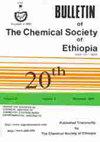同时测定人体尿液中尿素、肌酸酐和尿酸的比值导数过零和比值谱的逐次导数
IF 1.3
4区 化学
Q3 CHEMISTRY, MULTIDISCIPLINARY
引用次数: 0
摘要
摘要建立了两种简便、准确的分光光度法同时测定人尿中尿素、肌酐和尿酸三元混合物的方法。第一种技术是比值导数零交叉,在216.61 nm处测量尿素,260.56 nm处测量肌酐,283 nm处测量尿酸。第二种技术是比值光谱的连续导数,其中尿素、肌酐和尿酸分别在203 nm、261 nm和283 nm、287 nm测量。这些程序不需要分离。尿素、肌酐和尿酸在1.0 ~ 15.0 μg/mL、1.0 ~ 16.0 μg/mL和2.0 ~ 15.0 μg/mL范围内具有良好的线性关系。尿素加标回收率为97.10% ~ 101.9%,肌酐加标回收率为97.22% ~ 102.70%,尿酸加标回收率为97.45% ~ 102.55%,尿素加标回收率小于1.56%,肌酐加标回收率小于3.87%,尿酸加标回收率为3.71%。使用分析生态尺度和绿色分析程序指数工具来评估拟议程序对环境的影响。同时定量尿素,肌酐,尿酸在人类尿液样品可以完成显著的有效性使用建议的方法。关键词:尿素,肌酐,尿酸,导数分光光度法化学。Soc。阿比西尼亚人。2023年,37 (4),817 - 829 . DOI: https://dx.doi.org/10.4314/bcse.v37i4.2本文章由计算机程序翻译,如有差异,请以英文原文为准。
Ratio derivative-zero crossing and successive derivative of ratio spectra for simultaneous determination of urea, creatinine, and uric acid in human urine samples
ABSTRACT. Two simple precise and accurate spectrophotometric techniques are developed for simultaneous determination of ternary mixture of urea, creatinine, and uric acid in humane urine sample. The first technique is a ratio derivative zero - crossing where measured urea at 216.61 nm, creatinine at 260.56 nm, and uric acid at 283 nm. The second technique is a successive derivative of ratio spectra where urea, creatinine, and uric acid measured at 203 nm, 261 nm, and 283 nm, 287 nm, respectively. These procedures do not need separation. The proposed methods showed excellent linear range over the concentration ranges of 1.0–15.0 μg/mL, 1.0–16.0 μg/mL, and 2.0–15.0 μg/mL for urea, creatinine, and uric acid, respectively. The recoveries ranged from 97.10% to 101.9% for urea, 97.22% to102.70 % for creatinine, and 97.45% to102.55 % for uric acid with relative standard deviations less than 1.56% for urea, 3.87% for creatinine, and 3.71% for uric acid. The analytical eco-scale and green analytical procedure index tools were used to evaluate how the proposed procedures will affect the environment. The simultaneous quantification of urea, creatinine, and uric acid in human urine samples can be accomplished with remarkable effectiveness by using the suggested approaches.
KEY WORDS: Urea, Creatinine, Uric acid, Derivative spectrophotometry
Bull. Chem. Soc. Ethiop. 2023, 37(4), 817-829.
DOI: https://dx.doi.org/10.4314/bcse.v37i4.2
求助全文
通过发布文献求助,成功后即可免费获取论文全文。
去求助
来源期刊
CiteScore
2.20
自引率
8.30%
发文量
113
审稿时长
6-12 weeks
期刊介绍:
The Bulletin of the Chemical Society of Ethiopia (BCSE) is a triannual publication of the Chemical Society of Ethiopia. The BCSE is an open access and peer reviewed journal. The BCSE invites contributions in any field of basic and applied chemistry.

 求助内容:
求助内容: 应助结果提醒方式:
应助结果提醒方式:


